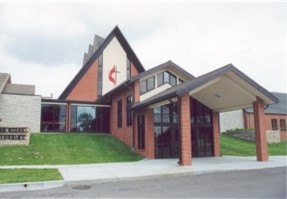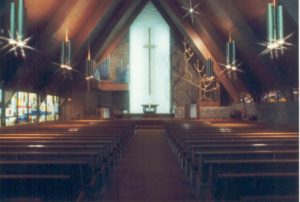Architecture and Stained Glass
West Entry Area

The Ceremonial Entrance on the west side of the church reaches out to the community welcoming them to join our fellowship. The glass entry with the towering roof gives a glimpse of the majesty within. The Cross and Flame on this side of the building, visible from Blue Ridge Boulevard, is the symbol of the United Methodist Church. The cross is the central symbol of the Christian faith and the red flame reminds us of the Holy Spirit’s presence in the life of the Christian today.
The west entry has two dominating windows, each expressing the life of a great apostle. The north window portrays the life of Peter. Reading from bottom to top, the first symbol readily noticed is the fisherman’s net, symbolizing Christ’s call to Peter and his brethren to become “fishers of men.” Next is the rock. It was on the rock of Peter’s faith that Christ said he would build his church. Next is the bell symbol of the church that was established here and that continues to live and ring its message to all the world. The seven flames symbolize the seven virtues which Peter expressed in his Christian commitment. Also depicted is the cock which crowed three times as Peter betrayed his Lord. Then over and above the cock, is Calvary’s Cross, symbol of Christ’s victory over sin and failure. The dove reminds us of the Spirit’s presence.
 The south window expresses the life of Paul. In the top left corner is a brilliant red banner which is symbolic of Paul’s conversion experience on the road to Damascus. Reading from bottom to top, the scrolls represent Paul’s own reliance on the writings of Scripture, as well as his many letters to early churches. The ship symbolizes his missionary journeys to establish churches throughout the Mediterranean world. The mast of the ship, in the form of the Chi Rho symbol, and the anchor, in the form of a cross, reflect that Christ was the dominant factor in Paul’s life. The dove again reminds us of the ever-present power of God’s Spirit in the life of the church.
The south window expresses the life of Paul. In the top left corner is a brilliant red banner which is symbolic of Paul’s conversion experience on the road to Damascus. Reading from bottom to top, the scrolls represent Paul’s own reliance on the writings of Scripture, as well as his many letters to early churches. The ship symbolizes his missionary journeys to establish churches throughout the Mediterranean world. The mast of the ship, in the form of the Chi Rho symbol, and the anchor, in the form of a cross, reflect that Christ was the dominant factor in Paul’s life. The dove again reminds us of the ever-present power of God’s Spirit in the life of the church.
The pulls on the entry doors and the sanctuary doors are originally designed. In the center of each is written a Psalm. The two Psalms depicted are:
Psalms 95:6,7: “O Come, let us worship and bow down, let us kneel before the Lord, our Maker for he is our God, and we are the people of his pasture and the sheep of his hand.”
Psalms 100:3,4: “Know that the Lord is God! It is he that made us, and we are his; We are his people, and the sheep of his pasture. Enter his gates with thanksgiving, and his courts with praise! Give thanks to him, bless his name!”
East Entry Area
 As you come into the church at the new northeast covered entrance, you will see three calvary crosses. These crosses remind us, each time we enter, of the Christ-like God who gave his own son in sacrificial love for all the world.
As you come into the church at the new northeast covered entrance, you will see three calvary crosses. These crosses remind us, each time we enter, of the Christ-like God who gave his own son in sacrificial love for all the world.
The central cross is the cross of Christ. Embedded with faceted purple art glass at the top of the perpendicular arm, it is symbolic of, “I AM the resurrection and the life….” Lower is the cross of the penitent thief. The lowest cross recalls the rebellion of man, the unrepentant lawbreaker.
The stained glass windows at this entrance state the Beatitudes given by Jesus in his Sermon on the Mount. (Matthew 5:3-11) The reception area that you enter at this door is called the Beatitude Room.
At the southeast entrance near Hobbs Hall is the window depicting “I AM the Good Shepherd.” (John 10:11)
Sanctuary
Because it symbolized Christ’s guiding presence in and through the church, I AM was chosen as the dominant theme of the sanctuary.
The windows on the north side of the sanctuary, viewed from the rear of the sanctuary to the front, incorporate several I AM symbols.
 “I AM the door” (John 10:9) “I Am the way (John 14:6) Symbolized by the door, the key, and the circle of eternity, all reminding us that Christ is the door-way of eternal life.
“I AM the door” (John 10:9) “I Am the way (John 14:6) Symbolized by the door, the key, and the circle of eternity, all reminding us that Christ is the door-way of eternal life.
“I AM the light of the world” (John 8:12) The large sun symbolizes the promise that those who follow Christ will not walk in darkness.
“I AM meek and lowly in heart.” (Matthew 11:29)…”My yoke is easy, and my burden is light.” (Matthew 11:28-30) When we take His yoke, we become like Him, meek and lowly of heart.
“I AM the King” (John 18:37) The Chi Rho monogram is a combination of of the first two Greek letters of the title “Christ.” The Chi Rho with the crown over the world symbolizes that Christ is the King.
“I AM” the bread of life.” (John 6:35) The shocks of wheat are symbolic of the words of Jesus that tell us just as we need bread to sustain our physical life, we must have Christ to sustain our spiritual life.
“I AM the truth” (John 14:16) The tablets of the Law express this truth. This is the last window before you reach the chancel area because it is from the chancel area that the truth of God is read and taught.
The windows on the south side of the sanctuary depict symbols from four of Christ’s parables.
“The Mustard Seed” (Mark 4:30-32)
“The Four Soils” (Matthew 13:3-9)
“The Three Treasures” (Matthew 13:44-48)
“The Blade and Ear” (Matthew 13:24-31)
The Chancel
The Chancel Area of the church is filled with symbolic meaning. The screen symbolizes the statement of Jesus, “I AM the vine.” The vine and branches remind us of both the diversity and the unity within the church. At the center of the worship setting is the round altar or communion table upon which are placed our offerings of praise and thanksgiving for Christ and where we celebrate his sacrifice for us in the sacrament of the Lord’s Supper.
Above the table, an empty cross reminds us of the victory of God in defeating sin and death. The white background symbolizes purity and the risen Lord. Use of stone in the chancel area is a reminder of Jesus’ statement that he would build his church upon a “rock.”
Three steps leading to the table remind us that we worship a “triune God” — Father, Son, and Holy Spirit. The lighted candles at worship time represent the triune God as the light of the world and that His light is present within us.
An open communion rail and pews with no ends assure that no barriers stand between those who worship here and symbolize our access to God through Jesus Christ.
The Chapel
 The windows in the Chapel tell the story of the life of John Wesley, founder of Methodism, and the spread of Methodism in America.
The windows in the Chapel tell the story of the life of John Wesley, founder of Methodism, and the spread of Methodism in America.
South windows show Wesley’s life in England
The branch plucked from the burning refers to Wesley being saved from a parsonage fire as a child. The book and quill refer to learning and the statements on Oxford and the Holy Club deals with the time in his life when he became a Christian.
Wesley’s conversion—dark side before, light side afterwards. “Out of the Deep I Call to Thee O Lord” comes from the day of his conversion when he went to church in the morning and the choir sang this psalm. “Christ has taken away the sins of all” refers to Wesley’s conversion experience.
Wesley’s preaching in England—in the factory, in the country. Right hand side is a symbolization of the Holy Spirit.
West windows depict the spread of Methodism
Spreading fields symbolizing the growth of America westward and the Methodist Church with the circuit rider. Under this is a statement of Wesley’s ——- “The way to be a Good Methodist is to be a Good Christian.”
We expand from the Methodist Church to Christ’s Church — “The way to be a Good Christian is to be Christ like.”
IHS is the three basic letters of the Greek word for Jesus. Also symbolized here are the three branches of Methodism in America—-Protestant Methodist Church, Methodist Episcopal Church and Methodist Episcopal Church South.
The last window depicts the presence of Christ in bringing the church back together. The right portion of this window is a depiction of the sacrament that unites all of Christ’s body. There is the communion cup, the grapes, and the wheat.
